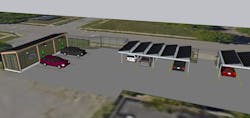On a Wing and a Prayer: Funding Microgrids for Low-Income Communities
In December 2023, a heavy winter storm hit Highland Park, Michigan, and the ensuing power outage lasted four days – a common occurrence in the community, which has a high poverty rate.
Residents, who can’t afford generators or hotel rooms, must often grapple with outages that last up to a week, said Juan Shannon, CEO of the entertainment company Modern Tribe Communications.
Parker Village seeks to provide local energy
In response to the outages, Shannon created Parker Village with plans to provide clean, local energy to the residents. Another goal is to keep wealth in Highland Park, which covers three square miles close to Detroit and ranks in the 94th percentile for low-income status in the U.S. with 45% of the population living at or below the poverty line
With support from the federal Department of Energy (DOE), the Union of Concerned Scientists (UCS) and others, Shannon is working on creating a smart, sustainable village in Highland Park that will feature clean, low-cost, local energy, including net-zero homes, two solar microgrids and an urban garden.
Part of the plan is a 2.9-square-mile transportation loop that runs one to two electric buses, with stops at a school and shopping areas. They’ll be charged by one of the two microgrids.
To date, the project, with some funding from the Wayne County Community Action Agency, has installed 4.5 kW of solar on a solar deck at Parker Village’s vegetable farm, along with a 9-kW battery. Shannon and his associates have refurbished some houses, making them energy efficient, and they plan to add solar on all new houses built, Shannon said.
Funding an obstacle for Parker Village and other community microgrids
However, the main obstacle standing in the way of accomplishing the plan is funding. Right now, the project is being funded on “a wing and a prayer,” said Shannon. In addition, the project needs people to write grant applications, he said.
While a number of new community microgrids are cropping up for low- to moderate-income residents who could benefit from clean, local energy, many face similar funding challenges.
Community microgrids as pilot projects
In fact, most community microgrids for low- to moderate-income neighborhoods in the U.S. are pilot projects funded by foundations, government agencies and others, said Lee Shaver, senior energy analyst for UCS.
Interest in community microgrids is growing. Costs are coming down, technology is easier to access, and Inflation Reduction Act incentives are lowering project costs and opening up tax credits for nonprofit organizations and municipal agencies, said Shaver. In addition, communities like Parker Village are experiencing more outages that last for longer time periods. And they want to decarbonize.
“None of the microgrids for low- to moderate-income communities are being paid for privately, as businesses or through conventional financing. They are all being paid for via grants and pilot programs–that continues to be an obstacle,” Shaver said.
California’s microgrid tariff efforts undermining community microgrids
In California, for example, stakeholders argue that the ongoing microgrid tariff case for community microgrids is holding up commercialization because the proposed tariffs don’t allow developers and owners to earn enough money for behind-the-meter projects.
“Folks in California were hoping for a pathway for private financing of community microgrids, and it stalled with the tariff,” said Shaver.
Number of utility-owned community microgrids growing
Front-of-the-meter projects owned and operated by utilities, on the other hand, are seeing more success because they’re often paid for through rates, said Catherine Von Burg, founder and former CEO and president of SimpliPhi Power.
These include eastern U.S. projects by Block Energy, under which the utility owns the microgrid and uses the company’s BlockEnergy technology. For example, utility Pepco, working with nonprofit developer Housing Initiative Partnership, will utilize the BlockEnergy residential battery storage system combined with rooftop solar at six family homesites in Fairmount Heights, Maryland. The homes will be marketed to first-time buyers who earn 80% or less of area median income.
“Utilities that oversee and seek rate increases are able to streamline projects because they’re a monopoly. If they control, own and operate assets, it’s more consistent with their business model,” Von Burg said. “All over the U.S., utilities working with public utility commissions and legislatures are creating roadblocks for behind-the-meter microgrids. It’s tough to develop a community-owned microgrid.”
Outside the U.S., fewer roadblocks
It’s easier to develop microgrids for low- to moderate-income microgrids in other countries, she added, citing SimpliPhi’s projects in Haiti and Myanmar as examples. That’s because there are fewer policies and regulations that stand in the way, she said.
In the U.S., some of the behind-the-meter microgrids either deployed or under development for disadvantaged communities include:
- The Get Lit, Stay Lit project, which has received funding from the DOE and Entergy New Orleans. Recently Entergy said it would provide an additional $250,000 grant to the project. Under an unusual approach, restaurants that receive microgrids at no upfront cost put $200 per month “back into the pot” for five years to help deploy additional microgrids.
- A solar microgrid in Castañer, Puerto Rico, funded by a grant from the U.S. Economic Development Administration to the Interstate Renewable Energy Council (IREC) and IREC’s partner, Pathstone. IREC is working in partnership with the Cooperativa Hidroeléctrica de Montaña – a local electric co-op that owns and operates the microgrid – the University of Puerto Rico in Mayagüez, and the local installation company Borintek. One objective is to identify local businesses that provide essential and nonessential services to low- and middle-income communities – and others – and ensure they have a path toward business continuity and energy resilience, said Carlos Alberto Velázquez López, IREC's program director in Puerto Rico.
- A microgrid that serves low-income apartments in Washington, D.C., and received funding from Pepco.
Microgrids for homeowners at no upfront cost
Meanwhile, in an effort that required no grants, Electriq Power’s PoweredUp Network is providing individual low-income and other homeowners and small businesses, mostly in California, with solar and storage microgrids at no upfront cost. The homeowners and small business owners pay 24 cents/kWh under power purchase agreements – a 20% discount on California utilities’ rates, said Frank Magnotti, CEO of Electriq Power.
Electriq Power has partnered with a company that provides financing options for residential clean energy to provide the microgrids for homes and small businesses using a power purchase agreement, he said.
Homeowners’ batteries can be used in utility virtual power plant (VPP) programs, which allow owners to earn money with their storage system and help create a more resilient electrical grid. Homeowners and small businesses can earn between a few hundred dollars and a few thousand dollars a year by offering storage systems to VPPs, he said. Right now, the company has 20 “network” installations in California, Magnotti said.
Maine legislation expected to give community microgrids a boost
While some states make it difficult to create behind-the-meter community microgrids, Maine has chosen the opposite strategy, said Shaver. Legislation now allows microgrid owners and developers to own and operate poles and wires on public right of ways.
“That’s a huge boon to community microgrids,” Shaver said.
Pilot projects yield education
While most community microgrids, especially for low- and moderate-income communities, receive funding from the DOE or other sources, they do provide important learning opportunities, said Shaver.
“The great thing about these projects: They are proving out the technology challenges. People in the communities find out how this impacts bills and whether people are going to go for community microgrids,” he said.
He noted, however, that many low- to moderate-income communities prefer to have control over their energy, rather than have utilities own the microgrids and sell power to them.
Or, as Von Burg put it, “Distributed energy resources are being sidelined in the name of utilities owning all electrons.”
About the Author
Lisa Cohn
Contributing Editor
I focus on the West Coast and Midwest. Email me at [email protected]
I’ve been writing about energy for more than 20 years, and my stories have appeared in EnergyBiz, SNL Financial, Mother Earth News, Natural Home Magazine, Horizon Air Magazine, Oregon Business, Open Spaces, the Portland Tribune, The Oregonian, Renewable Energy World, Windpower Monthly and other publications. I’m also a former stringer for the Platts/McGraw-Hill energy publications. I began my career covering energy and environment for The Cape Cod Times, where Elisa Wood also was a reporter. I’ve received numerous writing awards from national, regional and local organizations, including Pacific Northwest Writers Association, Willamette Writers, Associated Oregon Industries, and the Voice of Youth Advocates. I first became interested in energy as a student at Wesleyan University, Middletown, Connecticut, where I helped design and build a solar house.
Twitter: @LisaECohn
Linkedin: LisaEllenCohn
Facebook: Energy Efficiency Markets


